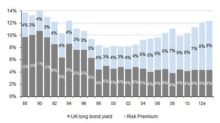Risky business

If something happens a lot, then a few bright sparks may deduce that the probability of it happening again will have gone up. It was on this theme and with reference to the longer term outperformance of equities vs bonds that a number of equity strategists were arguing for a structural decline in the equity risk premium (the additional return demanded over government bonds; albeit probably not any of the PIGGS) to justify a further surge in equity prices. It was October 1987 and I was returning from St Louis and little did I know that I (literally) and the market (figuratively) were flying into a hurricane.
In those days however the ‘equity risk premium’ was a still a fairly undeveloped area of study. Until the emergence of indexed linked gilts in 1981, markets were only guesstimating the inflation rate being priced into long gilt yields markets. Without this, determining a reliable forward looking estimate of the risk premium being priced into equities was impossible. Instead, most learned studies derived their equity risk premiums on a post-ante basis; effectively using the excess returns delivered by equities vs Gilts over various timescales. Unfortunately, this tended to reveal more about the mispricing of inflation expectations in historic bond prices than the forward risk premium required to hold equities. It also had the incongruous result of attempting to explain an inherently dynamic market with a static risk premium – it just doesn’t work! Market pricing feeds on changes in perceived risk and growth into the future rather an historic absolute of either.
So what is the risk premium being priced into equity prices and how does this compare with past levels?
Taking the UK FT All Share index as a representative equity market and using the UK long indexed linked yield as a proxy for a risk free return suggests the current (2011e) equity risk premium (ERP) of approx 6.8% within a total ECC (equity cost of capital) of around 11.3%. Historically, this puts the overall ECC at the highest levels since the early 1990’s with the ERP at record level having exceeded the spike in 2008.



